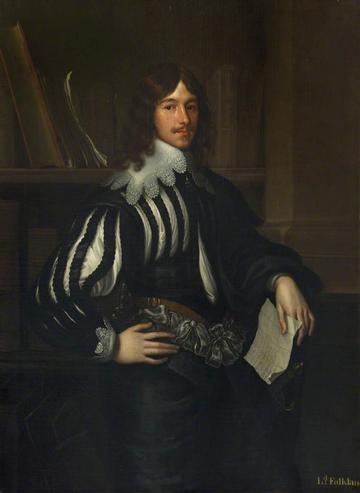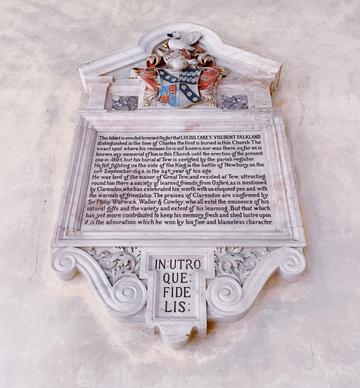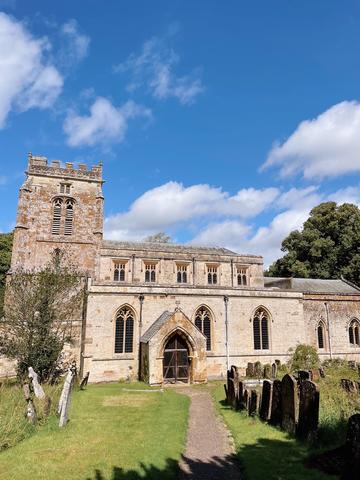Post-Mortem by Print: Reflections on the Death of Lucius Cary, 2nd Viscount Falkland

William Poulter is a postgraduate researcher at the University of Leeds, currently exploring the building of prodigy houses in Elizabethan England. The research for this blog was undertaken as part of a UNIQ+ internship at the University of Oxford in conjunction with the History of Parliament Trust.
Lucius Cary, Viscount Falkland, was killed fighting in the English Civil War on 20 September 1643. Explanations for his death range from suicide to an accident of curiosity. But perhaps more interesting to consider is how his fatality would be contested in print. As secretary of state to King Charles I, Falkland was a high-profile casualty and yet his death was largely ignored at the time. Examination of the immediate response to his death compared with the accounts in the 1660s makes clear the symbolic importance of Falkland to Restoration politics. The man who did more than any other to revive his memory for this later generation was Edward Hyde, earl of Clarendon and Charles II’s chief minister in the period 1660-7. And like other Restoration authors, Hyde could not resist invoking Falkland’s ghost for polemical effect.

Anthony van Dyck (1599-1641), Lucius Cary (1609/1610–1643), Second Viscount Falkland. [Oil on canvas]. St John’s College, University of Cambridge.
Falkland’s willingness to fight, and for whom, was clouded by his politics. Throughout the 1630s he patronised the Great Tew circle – a group of gentleman intellectuals who studied and socialised at his house in Oxfordshire. It was through this circle that Falkland met Hyde. They would forge a lifelong friendship based on shared political ideals. Contemporaries knew of the circle’s lukewarm support for Charles I’s authoritarian style of government. Falkland’s theorising on how England ought to be governed was best reflected in a speech he made to the Commons in 1641, where he claimed that ‘all the miseries we have suffered’ were the result of those advising Charles that ‘he might well do as he pleased’ (L. Cary, The Lord Faulkland His Learned Speech in Parliament (1641), 1-6 (E.196.9)). Despite his political anxieties, Falkland sided with the royalists at the outbreak of the Civil War in 1642 and accepted the office of secretary of state at Hyde’s urging. At the first battle of Newbury, he volunteered for action and was killed following a reckless charge at enemy lines. It is little surprise, then, that the royalist newsbook Mercurius Aulicus offered few words on Falkland’s death, only referring to him as being ‘most unfortunately slaine’ (Mercurius Aulicus no. 38 (17-24 Sept. 1643), 528-29 (E.69.18)). Falkland’s past criticisms of Charles’s rule may well explain why the response to his demise in the royalist press was so muted.
The response in Parliament’s leading newsbook, Mercurius Britanicus, implied that Falkland’s involvement in the battle had been an act of military necessity: ‘the King … was forced to command his principal Secretary of State … to help or all was lost’ (Mercurius Britanicus no. 5 (19=26 Sept. 1643), 39 (E.68.5)). A man of Falkland’s status being killed on the battlefield did not conform to Renaissance ideals concerning the role of ‘civil’ gentlemen in society. Instead, anachronistic concepts of masculine conduct are invited onto the page. Martial manliness, a product of an earlier age, was back in fashion as gentlemen took once again to their horses and armour. Falkland may have accepted this trend, and ‘rather chose to bury himself in the tomb of honour, than to see the nobility of his nation vassalaged, [or] the dignity of his country captivated by any base domestic enemy’ (E. Symmons, A Militarie Sermon (1644), 16 (E.53.19)).

Author’s photograph, 19 Aug. 2023. A wall-mounted memorial to Falkland, on the south chancel wall of the Church of St Michael & All Angels, Great Tew, Oxfordshire. Erected in 1885. Falkland was buried in the church, although the location is unknown, in 1643.
Following the restoration of monarchy in 1660, royalist politicians and polemicists sought to capitalise on Falkland’s memory for political and personal advantage. Chief among Falkland’s votaries was Hyde. As the main architect of the post-Restoration political order, he worked to establish ‘firmness and constancy’ (Clarendon, A Brief View and Survey of … Leviathan (1676), 124) within the new regime by promoting the ideals of the Great Tew circle. Hyde recast Falkland’s life and death to further the cause of constitutional royalism and promote a policy of reconciliation with former parliamentarians. He claimed that Falkland had willingly faced death at Newbury so that ‘all might see that his impatiency for peace proceeded not from pusillanimity or fear to adventure his own person’ (Clarendon, The History of the Rebellion and Civil Wars in England (1888), iii. 189). By offering Falkland’s body as an object of political violence, Hyde presented his death as an act of self-sacrifice in the cause of peace and settlement.
Hyde’s rise and, in 1667, fall influenced Restoration accounts of Falkland’s death. The poet and biographer William Winstanley, writing in 1665, was predictably admiring in his treatment of Hyde’s dead friend. According to Winstanley, Falkland achieved honour through the ‘just Defence of his Majesty, and the Laws … whose Cause they had so stoutly maintained’ (W. Winstanley, The Loyall Martyrology (1665), 60). Here, Winstanley sought to further Falkland’s (and Hyde’s) view that the king was bound by the law, and that the body politic could not operate without reverence for both.
Writing a year after Hyde’s fall from power, in 1668, another biographer, David Lloyd, could treat Falkland and his political legacy more critically: ‘This excellent Personage [was] among the Demagogues, that had been for twelve years silenced, and were now to play the prize in Parliament’ (D. Lloyd, Memoires (1668), 332). Lloyd was alluding here to Falkland’s cooperation with the parliamentarian politicians who had forced Charles I to recall Parliament in 1640 after over a decade of ‘personal’ royal government – a Parliament that would end up killing the king and abolishing monarchy altogether. In recounting Falkland’s death, Lloyd’s description was this: ‘his Curiosity engaging him at Newbury, he was strangely slain there, dying as he lived till then, between his Friends and his Enemies’ (Lloyd, Memoires, 333). Lloyd’s words were intended to highlight the conciliatory nature of Falkland’s politics and its ambiguous legacy for the adherents of the Stuart kings – both Charles I and Charles II. Hyde’s political supremacy and subsequent exile thus determined how Falkland was remembered and how his memory was exploited for political ends.

Author’s photograph, 19 Aug. 2023. Exterior of the Church of St Michael & All Angels, Great Tew, Oxfordshire.
The death and memorialisation of Falkland encapsulate the complex interplay of politics and conceptions of masculinity and honour during the mid-seventeenth century. Although his death received limited attention in 1643, it would later be re-contextualised for the political purposes of Restoration statesmen and writers. Hyde’s influential account of Falkland reflected their shared commitment to constitutional royalism and the search for settlement. The symbolic importance of Falkland was enduring as he was textually elevated from reluctant royal adviser to royalist martyr. Ultimately, his death provided a canvas on which portraits of the man and the cause for which he died could alternately be fleshed out and painted over anew.
Further Reading:
A. Hughes, ‘Manhood and Civil War’, in Gender and the English Revolution (Routledge, 2012), pp. 98-132.
C. Gray, ‘Wild civility: men at war in Royalist elegy’, in J. Feather, C.E. Thomas (eds.), Violent Masculinities: Male Aggression in Early Modern Texts and Culture (2013), pp. 169-89.
D. Smith, ‘Cary, Lucius, second Viscount Falkland (1609/10–1643)’, ODNB, (Oxford University Press, 2014).
S. Mortimer, ‘Great Tew circle’, ODNB, (Oxford University Press, 2007).
Biographies of Falkland and Hyde can be found in the newly-published House of Commons 1640-60 volumes.




